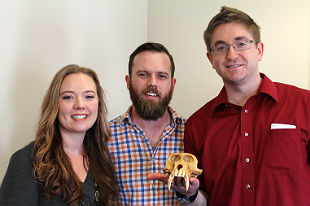SIU takes Dahlberg Prize

The illustrious Dahlberg Prize for 2014 was bestowed recently upon three doctoral students and an emeritus distinguished professor of Anthropology—Evan Muzzall, Ryan Campbell, Meadow Campbell, and Dr. Robert Corruccini. The prize recognizes the most excellent student paper, and was won at the Dental Anthropology Association meetings held this year in Calgary, Canada.
Titled “The effects of dietary toughness on occlusopalatal variation in savanna baboons,” Dean Susan Ford notes that this work is part of an ongoing series of research projects that the three students have been working on for several years with Dr. Corruccini, “as adjunct and in addition to their individual dissertation work.” The paper is currently under review by the journal Dental Anthropology.
The group has been looking at how differences in diet place different demands on the maxillae or upper jaws, contributing to either good occlusion or malocclusion of the teeth in the jaws, as well as other problems with the sinuses and airways. The students used crania and teeth obtained for Corruccini’s own research from a 1970s cholesterol study in which baboons were fed a soft diet of lard, butter, oatmeal, and the like. To these were contrasted samples from the Field Museum in Chicago, where baboons enjoyed a wild, natural diet.
What the prize winners discovered was that the soft diet sample exhibited both a shorter palate and more dental irregularities. As the entire chewing apparatus is integrated, when chewing stress is reduced through a soft diet, the bones of the skull and teeth do not develop properly and malformation is the result. The ramifications for the place of processed foods in the modern human diet, especially during development, are clear. Where bone is concerned, use is necessary for good development and maintenance.
But study of diet and chewing variations is also helping to refine the fossil record. What were thought to be new species may, in some cases, be diet-related variations. This study suggests that diet is an important factor for understanding species delineations more accurately.
Muzzall, Campbell, and Campbell are well into the second part of their study now, this time coordinating anatomical landmarks not with calipers, as they had in their original study, but using 3-D morphometrics, which uses a mechanical arm digitizer to analyze cranial shape variation within a coordinate-bound system. This allows capture of subtleties frequently missed with other types of measurement. In the meantime, you can bet they’re packing their carrot sticks along for lunches!
L. A. Brown
